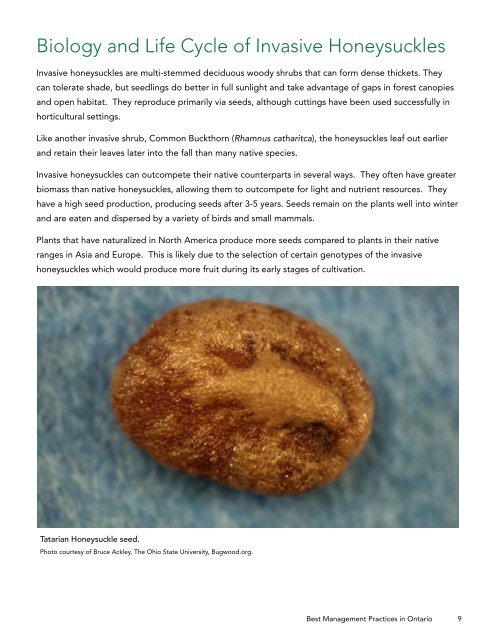OIPC_BMP_Honeysuckle_Feb182014_FINAL2
OIPC_BMP_Honeysuckle_Feb182014_FINAL2
OIPC_BMP_Honeysuckle_Feb182014_FINAL2
Create successful ePaper yourself
Turn your PDF publications into a flip-book with our unique Google optimized e-Paper software.
Biology and Life Cycle of Invasive <strong>Honeysuckle</strong>s<br />
Invasive honeysuckles are multi-stemmed deciduous woody shrubs that can form dense thickets. They<br />
can tolerate shade, but seedlings do better in full sunlight and take advantage of gaps in forest canopies<br />
and open habitat. They reproduce primarily via seeds, although cuttings have been used successfully in<br />
horticultural settings.<br />
Like another invasive shrub, Common Buckthorn (Rhamnus catharitca), the honeysuckles leaf out earlier<br />
and retain their leaves later into the fall than many native species.<br />
Invasive honeysuckles can outcompete their native counterparts in several ways. They often have greater<br />
biomass than native honeysuckles, allowing them to outcompete for light and nutrient resources. They<br />
have a high seed production, producing seeds after 3-5 years. Seeds remain on the plants well into winter<br />
and are eaten and dispersed by a variety of birds and small mammals.<br />
Plants that have naturalized in North America produce more seeds compared to plants in their native<br />
ranges in Asia and Europe. This is likely due to the selection of certain genotypes of the invasive<br />
honeysuckles which would produce more fruit during its early stages of cultivation.<br />
Tatarian <strong>Honeysuckle</strong> seed.<br />
Photo courtesy of Bruce Ackley, The Ohio State University, Bugwood.org.<br />
Best Management Practices in Ontario<br />
9



